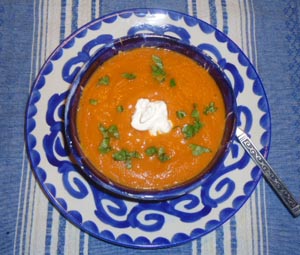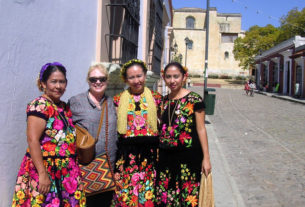
Years ago, when we had more endurance for late-night fiestas, part of the next morning’s ritual was a visit to Martita, the “juice lady,” at her stand alongside the Cholula plaza. Her carrot and orange juice blend, with its bright taste and color, was an instant pick-me-up, providing potent boosts of vitamins A, C, and antioxidants.
I hadn’t given much thought to carrots in Mexican cooking until doing a recent search for carrot cake recipes, when it dawned on me that carrots are found in just about every kind of dish in Mexico, from salads to desserts. They are a reliable standby, sold in even the smallest markets.
It seems that carrots are so taken for granted that we don’t realize, until doing a little research, that, besides being a workhorse in the kitchen, the carrot is a nutritional powerhouse, providing over 100 percent of the daily requirement of Vitamin A, as well as C and B vitamins, along with several trace minerals, in one cup of the sliced, raw vegetable. In addition, this humble root contains valuable amounts of the antioxidant beta carotene, which was named after it.
A member of the plant family called umbelliferae because of their umbrella-like clusters of flowers, the carrot has some tasty relatives, including fennel, anise, cumin, caraway and dill, which might account for its aromatic flavor. Usually associated with the color orange, carrots also come in white, yellow, red and purple. This brightly colored part of the plant, the one we eat, is the taproot.
Although carrots, as well as several other vegetables, are not typically found on Mexican restaurant menus, they are a ubiquitous part of Mexican home cooking. The trusty Larousse de la Cocina Mexicana tells us that they are available in markets year-round, and this convenience — along with low price and ease of preparation — make the carrot a no-brainer for addition to the soups and stews that are fundamental elements of the home cooked comida.
The carrot is a basic ingredient of countless caldos (soups and broths) and stews. It is part of the flavor base of most chicken and beef stocks, and a flavoring in itself. It is especially appreciated in such Mexican classics as caldo tlalpeño, a chicken vegetable soup, and caldillo de chambarete, a brothy version of the Spanish chambarete español, made with beef shanks.
Besides being used in countless meat and poultry dishes, carrots are pickled, most often with jalapeños or potatoes, and served as a botana, a favorite bar snack throughout the country. Carrots make a fragrant side dish flavored with vanilla in the Sierra Oriente region where vanilla originated, and play an important part in ensalada rusa, the carrot and potato salad popular in central Mexico. They are diced and added to both red and white rice with their faithful companions, peas.
But how did a vegetable that originated in Asia, and was literally unheard of in pre-Hispanic America, become such an indispensable culinary ingredient in Mexico? The answer, of course, lies in the Age of Exploration, that adventurous period during the 15th and 16th centuries when Europeans took to the seas in search of new goods and trade routes.
The Moors had brought the carrot to Spain the 12th century, having brought it themselves from farther east. According to the World Carrot Museum (this exists and has a website) carrots originated about 5,000 years ago in the area of what is now Afghanistan. When the Spaniards got to the New World (and, leaving from the western Mexican coast, to Asia) a tremendous interchange of agricultural resources was born, and carrots were one of many that thrived in Mexico.
Today, the states of Mexico and Baja California lead the country in carrot production. Mexico is one of the largest carrot producers in the world and, along with Canada, the largest source of carrots imported by the US, and the top source of prepared frozen carrots consumed in the US.
Fresh carrots last longer than most other vegetables, and should be stored in the coolest place possible. Preferably, this would be the coolest part of the refrigerator, although I remember staying at a ranch in Baja California where electricity was only available for a few evening hours a day, and carrots and other hardy produce stored there without refrigeration did surprisingly well.
When buying, select carrots that are firm, smooth and bright in color, since deeper orange carrots contain more beta carotene. If buying carrots without the tops, look for a stem end that isn’t too dark a green color, since this indicates age. I have seen some prepackaged carrots that have a nearly black stem end, and these are to be avoided. The tops should be cut off before refrigerating, since the carrots will wilt faster with the tops attached.
If carrots are young and grown organically, they can be scrubbed rather than peeled; otherwise, peel them. They are delicious raw, and a regular on crudité trays, served with dips. Unless adding them raw to a soup or stew, they are best steamed rather than boiled. In fact, according to a report in the Journal of Agriculture and Food Chemistry, cooked carrots provide more antioxidants than raw ones.
The mild taste of carrots means they will take on the flavor of spicier companions, and they are a natural with jalapeños. They also go well with such characteristic Mexican ingredients as cumin and cilantro. Use them in stocks, soups, stews, and salads. Carrots are a wonderful base for a Mexican vegetable pudding, or budín. These are most often made with peas, but carrots make a fine budín, one that can be made with cheese and served as a savory side dish, or with brown sugar, nuts and raisins for a tasty dessert.
Following are some recipes using this healthy ingredient in Mexican dishes, so get your orange on and feel good about doing it.
- Mexican carrot salad with jalapeño: Ensalada de zanahoria con jalapeño
- The comadre’s Russian salad: Ensalada rusa de la comadre
- Mexican-style beef in broth with carrots: Chambarete en caldillo con zanahorias
- Mexican steamed carrots with vanilla: Zanahorias al vapor con vainilla
- Mexican carrot pudding: Budín de zanahoria



“umbelliferae” not “unbelliferae”
Do you know the variety name for the giant, fat carrots they grow in Mexico?
Thanks for pointing out the typo, now corrected. Sorry, but I don’t know the variety name.